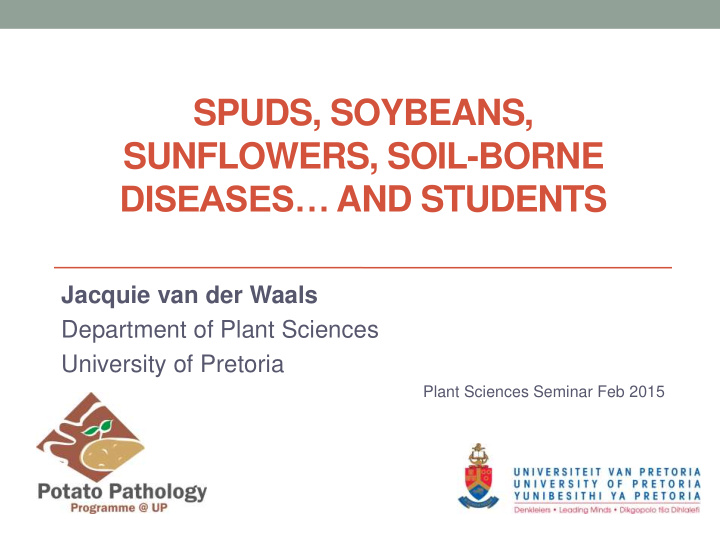



SPUDS, SOYBEANS, SUNFLOWERS, SOIL-BORNE DISEASES… AND STUDENTS Jacquie van der Waals Department of Plant Sciences University of Pretoria Plant Sciences Seminar Feb 2015
“What I say is that, if a fellow really likes potatoes, he must be a pretty decent sort of fellow ” ( AA Milne, 1882 – 1956)
Foliar diseases
Wilts
Tuber diseases
Foliar diseases
BROWN SPOT ( MALROES ) "There are no foolish questions and no man becomes a fool until he has stopped asking questions." Charles P. Steinmetz
Brown spot – Alternaria alternata • Reduced sensitivity to azoxystrobin found in field isolates (Mr Joel Dube MSc 2014) • van der Waals et al. , 2011 • Dube et al., 2014
Management of brown spot • Mr Newman Nyoni MSc • Development of management strategy for brown spot of potatoes • Fungicide spray programmes • Effect of N nutrition
Wilts
SOFT ROT AND BLACKLEG “Concern for man and his fate must always form the chief interest of all technical endeavours. Never forget this in the midst of your diagrams and equations.” Albert Einstein
Soft rot and blackleg
No Pectobacterium wasabiae or Dickeya solani found (Ngadze et al., 2012) 2010: FIRST REPORT of Pectobacterium carotovoum subsp. brasiliense in South Africa – most important pathogen in SA No Pectobacterium atrosepticum or Dickeya solani found (Van der Merwe et al., 2010)
Soft rot / blackleg cont. • Role of phenolic compounds in disease resistance (Ngadze et al., 2012) • Effect of calcium soil amendments in disease resistance (Ngadze et al., 2014)
Soft rot / blackleg cont. • Effect of temperature on growth of Pectobacterium and Dickeya spp. in vitro ( Susan du Raan, MSc 2015) Optimal Temperature Species Temperature Growth Range
Implications? Climate change = 2 o C (van der Waals et al., 2013) Temperature = Disease Species shift Pa, Pw Pcb, Pcc Dd, Ds
BACTERIAL WILT
Characterisation of bacterial diseases of potato in Nigeria Vou Shutt Moses PhD i. Survey of bacterial diseases of potato in Nigeria ii. Isolate and identify bacteria iii. Determination of genetic diversity of strains ( Ralstonia solanacearum, Pectobacterium spp. and Dickeya spp.) iv. Study response of different potato varieties in Nigeria to these bacteria F. Niederwieser
Tuber diseases
SOIL-BORNE DISEASES Powdery scab, common scab, black scurf, silver scurf, black dot, dry rot
POWDERY SCAB “Confidence is the feeling you sometimes have before you fully understand the situation.” Unknown
POWDERY SCAB • Most devastating and economically important disease in many potato growing regions of the world • Integrated management of disease • Detection and eradication of pathogen in contaminated tunnels (Wright et al. , 2012) • Soil amendments: chemicals and biological control agents • Cultivar susceptibility screening • Development of bio-assay for on- farm testing of soils (“grower friendly”) • Best crops to plant in rotation programmes with potatoes
Determination of host range of pathogen Kennedy Simango PhD Chris Slabbert MSc Effect of soil amendments Development of bioassays on disease development Chris Slabbert MSc Kennedy Simango PhD Genetic diversity of Role of soil temperature Spongospora subterranea and moisture in infection f.sp. subterranea process Kennedy Simango PhD Chris Slabbert MSc Jessica Wright MSc 2013 Cultivar susceptibility Powdery screening -Pot trials scab Survival in soil (long-term -Field trials study) management -Phenolic content Kennedy Simango PhD NOTE: PhD / Post-doc positions available on this project
RHIZOCTONIA RESEARCH "Discovery consists of seeing what everybody has seen and thinking what nobody has thought." Albert von Szent-Gyorgy
(A. Pitman, New Zealand) Rhizoctoniasis
Characterisation and symptomatology of Rhizoctonia solani associated with potato diseases in South Africa Mr Norman Muzhinji PhD • A survey of anastomosis groups and genetic diversity of Rhizoctonia solani on potatoes in SA • AG 3 was shown to cause elephant hide on potatoes in South Africa; Binucleate Rhizoctonia stem canker (Muzhinji et al., 2014a,b) • Effect of inoculum source on disease development • Population structure of Rhizoctonia solani AG 3-PT field populations revealed by microsatellite markers • Screening of Rhizoctonia solani isolates to various fungicides
ATYPICAL TUBER BLEMISHES “If we knew what it was we were doing, it would not be called research, would it ?” Albert Einstein
Spatial and temporal ( Josephine Zimudzi, PhD ) changes in the structure of microbial communities of the potato rhizosphere and the possible effects thereof on development of atypical tuber blemishes Wooley et al., 2011
CROP ROTATION
Root associated micro-organisms and their role in crop production in a region-specific crop rotation program for the Eastern Free State Mr Joel Dube PhD • Use of metagenomic methods to investigate the role of root associated microorganisms in crop productivity • Main crop: potatoes; Rotation crops: maize, sugar beans, sunflower and soybean • Monitor microbial populations associated with rhizosphere and rhizoplane over full annual cropping cycles • Identification of microorganisms that are key members of these two zones
SUNFLOWERS AND SOYBEANS
Etiology and population structure of Macrophomina phaseolina (charcoal rot) on sunflower and soybean in South Africa Mrs Estiene Jordaan PhD • Development of a pathogenicity screening assay for soybean and sunflower • Determine diversity of M. phaseolina isolates from various crops (in particular sunflower and soybean) in South Africa • Role of various factors such as temperature, preceding crop and pH on growth rate of isolates
Final year BSc Agric students • Mr Steve Nel • Biocontrol of charcoal rot of soybean caused by Macrophomina phaseolina • Mr Sepeke Ratau • Evaluation of fungicides for control or inhibition of Sclerotinia sclerotiorum soybean isolates in vitro
Acknowledgements • Funding bodies: • Potatoes South Africa • Protein Research Foundation • NRF • THRIP • Commercial growers (field trials) • AgChem Companies (field trials) • Seed companies (field trials • Collaborators / Co-supervisors: • Prof Teresa Coutinho • Dr Linus Franke (UOFS) • Dr Anton Haverkort (Plant Research Int’l, Wageningen) • Prof Nico Labuschagne • Prof Martin Steyn • Dr Mariette Truter (ARC) • Dr Leah Tsror (Volcani Institute, Israel) • Dr James Woodhall (Fera, UK) • Ms Lindie Erasmus
Recommend
More recommend